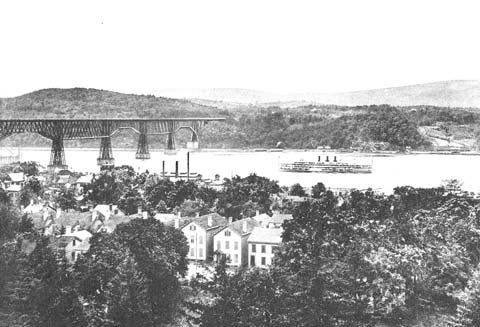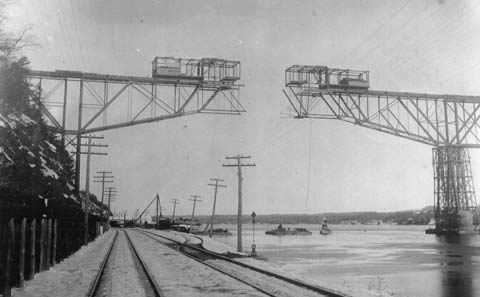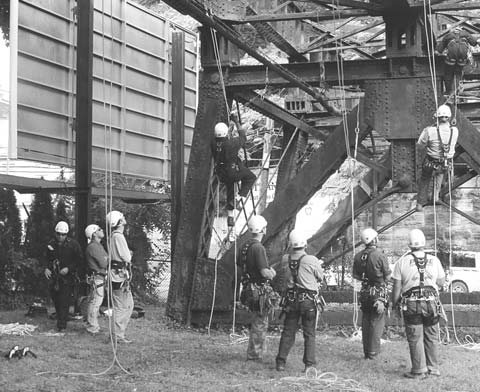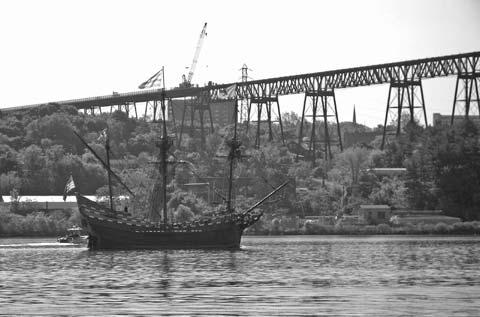Span of Time
Walkway Grand Opening Celebration Oct 2–4, 2009
Fall 2009

This postcard taken from the Poughkeepsie side of the Hudson, shows one of the steam driven ships approaching the railroad bridge from the north. The photo may have been shot from College Hill.
1974, Fire!
Flames rose from the oil soaked railroad ties as charred debris rained down on the buildings, roads, and properties in Poughkeepsie. Our vantage point, on the West shore of the Hudson River, was about a half mile north of the burning railroad bridge. We viewed the fire from the site of Bellevue Villa, also destroyed by an unstoppable fire in the winter of 1904. The five-story hotel had been built in the 1870s by Abram and Elizabeth Hasbrouck. The hotel had no water available to fight the fire. Seventy years later, like the hotel, there was no water and seemingly no way to stop this fire on the bridge. Ground-level fires sparked by falling timber splinters were equally problematic—a number of warehouses under the bridge as well as a large round natural gas storage tank were threatened.
Putting out these ground-level fires and hosing down other endangered structures kept the mutual-aid fire companies on the Poughkeepsie side of the river occupied. That day over 700 feet of bridge deck planking and old railroad ties went up in sooty, oil-blackened smoke, one more exclamation point in the bridge’s long history.
Additional heroic firemen, these from Highland, came across the bridge, successfully bringing water to the conflagration. The span had been just too high to reach with conventional fire trucks from the ground below in Poughkeepsie.
The May 8, 1974 fire ended all rail traffic across the Great Poughkeepsie Railroad Bridge. The fire began the saga that leads to the magnificent celebration planned for October 2, 3, 4, 2009.
Several years after the 1974 fire, and after a fireworks display, the bridge caught fire again. This time, we watched as a helicopter scooped water from the river into a huge bucket hanging from its belly. It flew above the bridge disgorging the water onto the flames. It took several hours and many refills, but apparently someone had given after-thought to the fire of 1974.

The Poughkeepsie Highland Railroad Bridge begins…
Distant past.
For at least fifty years before it was finally undertaken, people had talked about and planned the building of a rail bridge to span the Hudson between Highland and Poughkeepsie. East-west rail access would be a boon to everyone. Well, perhaps not everyone as the ferry business between Highland Landing and Poughkeepsie would surely be displaced.
In 1871, the Poughkeepsie Bridge Company was incorporated in New York State. The company’s stated purpose was the construction, operation, and maintenance of just such a bridge as had been considered for the last half century. Among the original incorporators were two Ulster County residents, Anning Smith of Milton and Abram Hasbouck of Highland, builder of Bellevue Villa.

Almost finished. The sides are drawing together in this 1887 photo of the great Highland-Poughkeepsie Railroad Bridge. First constructed to carry one train, it was later reinforced and able to carry two trains simultaneously. The structural integrity of the bridge was completely examined in 2008. It was found to be in excellent condition and suitable to become Walkway Over The Hudson.
After several fitful starts, additional incorporations and seventeen years, the first locomotive chugged across the 6,767 foot span on December 29th, 1888. Part of the Hartford and Connecticut Line, the bridge was the second largest in the world. It was structurally enhanced to support two sets of track, and continued in operation for the next 86 years, although it eventually was reduced back to a single line of track.
Many of the laborers who helped build the rail bridge were Italian immigrants. They settled in the area, on both sides of the Hudson, introducing spaghetti, tomato sauce, and the ubiquitous zucchini. Happily, many brought their wine making skills as well. The Italian areas of Poughkeepsie and Highland may have had their genetic roots in Italy, but their new world roots are firmly set in the great stone foundation piers of the railroad bridge.
Equally important to the structural integrity of this great bridge are two additional factors: First, the natural cement for the bridge was mined in Rosendale. This cement is among the best in the world, curing above and below water and becoming harder and harder over time. The other important factor is the high quality of the steel which came from the Carnegie steel mills in Pennsylvania.

The inspection process for the bridge required every inch of the structure to be examined within an arm’s length. The photo above, from Walkway’s collection, shows the inspectors beginning their challenging work. The metal for the structure was produced by Andrew Carnegie’s mills and shipped by rail to the site. With his name so closely connected with this marvel of engineering, Carnegie sent the best his mills could produce and cited as part of the reason the bridge remained in such good condition.
Steve Brodie, famous Brooklyn Bridge jumper, purportedly dropped from the 212 foot Poughkeepsie-Highland Railroad bridge on November 9, 1888. There seems to be no proof or consensus that it actually took place, but in bridge lore, a Brodie claim was almost as good as a Brodie feat.
The financial ride of the bridge has not been a smooth one. In 1892, during a recession, the bridge was sold at mortgage foreclosure. Purchased for $2.5 million, the Philadelphia and Reading Rail Road Company took control. Later the bridge changed hands again, this time into the system of the New York, New Haven and Hartford. At the time of the 1974 fire it was part of Penn Central.
Passengers as well as freight crossed the bridge regularly into the 1920s. Beginning in 1897, you could board an electric trolley along its six mile route from New Paltz to Highland’s Pratt’s Mills. At Pratt’s Mills Station the car was pulled by a small locomotive-called either the “Dummy” or the “Dinkey.” The wheels of the trolley cars had been adapted to run on either the trolley bed rails or the train track of the rail bridge. It isn’t hard to imagine the thrill (!) of crossing that span, over 200 feet above the Hudson in an open-air car, with no superstructure obstructing your view. You did not have to go over the bridge. At Pratt’s Mills you could also continue by trolley to the Highland Landing (also called New Paltz Landing or Yelverton’s Landing, among other names, and today the Bob Shepard Highland Landing Park) and ferry across.
The trolley rail bridge service was discontinued even before the trolley was abandoned in 1925. (See Glendon Moffet’s book Down To The River By Trolley: The History of the New Paltz-Highland Trolley Line.)
In the summer of 1992, the last time we wrote in About Town about the rail bridge, its ownership was contested. In addition, the City of Poughkeepsie and Dutchess County had tax claims on it for more than $100,000. US Coast Guard and others concerned with public safety wanted it demolished. City of Poughkeepsie resident William Sepe dreamed of saving the historic structure (it’s a registered national landmark) and making it a pedestrian walkway.
I wrote at the end of the article, “Right now, the railroad bridge is hard to miss, an iron girded relic to the nation’s glorious railroad heyday. Soon, it may be gone, and not so hard to miss, unless, of course, you’ll remember when it was there.”
A lot of water has gone under that bridge since I wrote those words. Bill Sepe succeeded in organizing a grassroots effort to acquire the bridge, and spearheaded the group that would ultimately succeed in not only owning the bridge, having liens forgiven, but later under the leadership of Fred Schaeffer, bringing the dream to reality.

Bridge work, May 2009. Truck delivers materials to workers on Walkway and note workers’ scaffolding on bridge pier on right. Mid-Hudson Bridge is behind Walkway.
August 2009
The huge cranes and trucks move relentlessly toward the middle of the span from east and west, laying the steel reinforced concrete slabs and then using them to inch toward the opposite shore. Every day I am amazed at the progress of this transformation of materials into an attraction that will ignite tourism for the mid-Hudson Valley, and give residents access to the cooling breezes and unparalleled views of the Hudson.

The Halfmoon passes under the Poughkeepsie Railroad Bridge on its way to the Hudson Fulton Celebration. It had spent the night at the Marist College boat launch.
Walkway is the product of many minds, beginning with the dreamers in the 1830s who wanted to ship goods across the Hudson. The Walkway’s Grand Opening Celebration in conjunction with the Hudson-Fulton-Champlain Quadricentennial Celebration takes place on October 2nd, 3rd, and 4th. It’s hard to record all the people who have had a hand in this great addition to Hudson Valley life. However, I want to start with Anning Smith, and Abram Hasbrouck and all the other original investors for financing the idea and keeping it alive; the engineers who designed such a beautiful, enduring structure, to the Snyder and other cement companies and workers in Rosendale; to the stone masons, ironworkers, and laborers who toiled and sometimes suffered injury and death; to Andrew Carnegie and his steel mills; to the fire fighters who saved the bridge; to Bill Sepe for his dream and determination; to the many Board Members of Walkway Over The Hudson for their perseverance and good sense; to the Dyson Foundation for its generous support; to the taxpayers and governing bodies in Dutchess and Ulster Counties; to Central Hudson; and finally, ultimately, to the huge cost of tearing it down (a much larger cost than this transformation).
![Walkway Over The Hudson [image: Bergmann Associates]](https://abouttown.us/wp-content/uploads/2016/08/span2.jpg)
Illustration, by Bergmann Associates (the project engineers), of the structure’s future that begins October 2,’09. Photo from the archives of the Walkway Over The Hudson. See more at www.walkway.org.
The Future
The future begins October 2. As I write this, Jeanne Flemming is completing the plans for “Walking On Air,” Walkway’s opening celebration. Groups on both sides of the bridge are sewing flags, making puppets, and learning their20roles in this grand event. It’s a “once in a lifetime” that we participants will be able to talk about for the rest of our lives. And, every time we “walk on air,” 212 glorious feet above (dare I say it?) the most beautiful river in America, we will know whom to thank—if we can take our eyes and minds off the view.
The Walkway is the longest, highest linear park in the world. You can cross by foot, rollerblade, bike, wheelchair, stroller, wagon, Segway, or in your parent’s backpack.
See you on the Walkway.

1909 Hudson Fulton Celebration postcard shows the decorations for the celebration are electric lights on Main Street in Poughkeepsie. Note double set of trolley tracks. (From collection of Vivian Yess Wadlin.)
